Kickstarter Referrals Explained: Metrics Of 4 Funded Tabletop Campaigns
December 16, 2020
Crowdfundingnerds.com

In 2020, Crowdfunding Nerds have helped 22 board game campaigns meet their funding goals, with 18 funded on the very first day of their launch. Seventeen of these Kickstarter campaigns have been from first-time creators who couldn’t piggyback on past achievements.
The key to the success of these Kickstarter projects has everything to do with pre-marketing strategy. In our view, your success has everything to do with the quality of marketing carried out before the Kickstarter campaign goes live.
The results of our clients funding on the first day cannot be attributed to Kickstarter itself (especially when clients have no previous Kickstarter campaigns under their belt). If it were a result of the platform, then all you would need to do is submit your game and sit back, letting Kickstarter do the rest. This obviously does not happen.
…at least, I hope it’s obvious!
In this article, I want to dive deep and show you the behind-the-scenes referrals of 4 successful tabletop campaigns we managed. From this, you should have a good idea of what results you should expect from Kickstarter. We are going to simplify conclusions as much as possible so that you can extrapolate the amount of pledges you need to personally drive in your campaign in order to reach your funding goal.
We have chosen a broad range of examples to get the best data possible, from projects that blew up on the first day, to others that took a little more time and raised a more humble amount. These projects include:
- Rurik: Stone & Blade – 2,968 backers and $210,564 in pledges
- Board Game Design Starter Kit – 1,496 backers and $72,683 in pledges
- Commissioned: The Call – 865 backers and $46,953 in pledges
- Fugue – 173 backers and $3,004 in pledges
Cloak-And-Dagger
What makes the quest to discover a marketing campaign’s return on investment troublesome is how Kickstarter ambiguously lists referrals. Kickstarter likes to take the spotlight when conveying your analytical referrals; however, it is a little more complicated then what is initially presented by the platform.
Let’s be clear; Kickstarter certainly does help draw a larger crowd and push your campaign. In fact, we can confidently attribute 1,049 backers that generated $80,726 to Kickstarter alone from the Rurik: Stone & Blade campaign. From our experience, however, it is necessary to get the ball moving and continue to fan the flames of user engagement before your launch to activate this inbuilt traction on the platform.
In October 2020, Mike Gnade of Rock Manor Games wrote a post breaking his previous campaign’s Kickstarter referrals into three categories to understand the effect that advertising/marketing has had on his campaign. We mostly agree with his summary, but we’ll go into specifics using our own examples.
Our three categories for all the Kickstarter referral types are
- Hard Kickstarter Leads,
- Soft Kickstarter Leads, and
- User Leads.
Crash Course 1: Why You Should Care
We’re about to get really nerdy, so we need you to understand the practical side of why you should keep reading.
Your marketing dollars spent on Kickstarter ads will have a certain return on investment.
If that investment looks profitable, you’ll spend more. If it’s neutral (or negative), you’ll probably keep spending at a similar amount (or try something else).
But if you know that your marketing efforts are bringing in 67% more backers than you think (that aren’t directly tied to your ad spend), you’re going to make decisions differently.
A Facebook Ads campaign that looks somewhat profitable would in actuality be extremely profitable. A campaign that is neutral would be profitable. See where we’re going with this?
More on this in the conclusion of this article.
Crash Course 2: Marketing Logic
Before we dive in, we need to understand some fundamental logic to make actionable and accurate conclusions on the Kickstarter referral data. Logic is the study of correct thinking and can help us decipher truth from error. Within logic, there are two types of arguments that must be clarified. These are deductive arguments and inductive arguments.
Deductive arguments are either true or false. An example of a deductive argument is one based on the scientific method and direct observation. For example, water reaches boiling point at 212°F / 100 °C at sea level. This statement is either true or false and we can test it to determine the quality of the argument.
Inductive arguments, on the other hand, are categorised as strong or weak and are susceptible to change with adding information. They refer to past events which we can’t replicate and test in front of us. An example of a strong inductive argument would be this:
“We will have ice cubes tonight because Jim put a tray of water in the freezer this morning.”
This argument logically follows and there is a strong reason to believe the conclusion. It is important to realise that strong inductive arguments can be altered by new information. If I were to add the following key information:
“The freezer is broken.”
Suddenly, this strong argument becomes an incredibly weak argument for having ice cubes in the evening.
So, how is any of this relevant to marketing? When examining the source of Kickstarter referrals, we’re dealing in the realm of induction. We are providing you with the most reliable information possible from our own tracking and marketing data to present the strongest arguments. While we are dealing in the realms of strong or weak probabilities, we have done our utmost to make sure that the data presented is accurate and convincing.
Hard Kickstarter Leads
Hard Kickstarter Leads include individuals who found you on Kickstarter and support your project. These are individuals we can, with enthusiasm, thank Kickstarter for finding, and include:
- Advanced Discovery – The Kickstarter explore and search filters used to find your game.
- Discovery – Related topics used to suggest your game to users browsing Kickstarter.
- Recommendations – Your game is recommended to a Kickstarter user on their home page or the footer of similar games.
- Internal – A pledge internally sourced from Kickstarter but not related to the discovery and recommendations already defined.
- Email – An email from Kickstarter notifying the individual that an acquaintance has backed your game.
- Activity Feed – Lists user activities on Kickstarter and includes updates about projects they have supported. If customers are following you as a designer or creator then they will be notified about your new project here.
Soft Kickstarter Leads
Soft-Kickstarter Leads are pledgers that came to Kickstarter looking for you and already knew about you from another source. In this case, Kickstarter helped close the gap. These leads would not have been possible with your efforts alone and would not have been possible with Kickstarter alone. Think of them as a handshake between you and Kickstarter.
- Email – This can be included in your email referrals. Sometimes Kickstarter will email particular projects to certain people, and this could be a legitimate hard lead.
Alternatively, Kickstarter users can opt-in for a 48-hour reminder to back your game before the campaign ends by tapping “remind me” on your project page. Leads generated this way could have been sourced through your ads, content creation or Facebook groups, which indicates that email represents a large number of Soft Kickstarter Leads. Your active involvement is needed to acquire these leads.
- Follow – When someone visits your designer profile page, they have the option to follow you and receive updates on your future projects. Like the email leads, these followers could have been found organically on Kickstarter or be a direct result of your marketing efforts.
User Leads
User Leads are directly attributed to you. This includes your ability to mobilise your fan base by cultivating an engaged email list, Facebook Group or YouTube Channel, among others. User Leads are also acquired through the effectiveness of your landing page and advertising efforts through Facebook ads or third-party reviewers.
Search – There is a possibility that while browsing Kickstarter, a pledger saw your game went away and came back to it by searching for you within Kickstarter. This is rather unlikely, however, as people tend to only commit games to memory if they intend to back the project. It is far more likely that these searchers represent people coming to Kickstarter with your game already in mind and seeking to find you quickly.
Push – Your pre-launch Kickstarter landing page has the option for individuals to receive push notifications on their mobile phones once you launch. Pledges from this referral stream would have resulted in your efforts to attract people to your pre-landing page.
External – The acquisition of backers from any non-Kickstarter page, including social media sites or your own website.
Understanding Rurik: Stone & Blade Referrals
Rurik: Stone & Blade had 102 different types of referrals. Using our above-defined categories of Hard Kickstarter Leads, Soft-Leads and User Leads, we can represent this data in a pie chart:
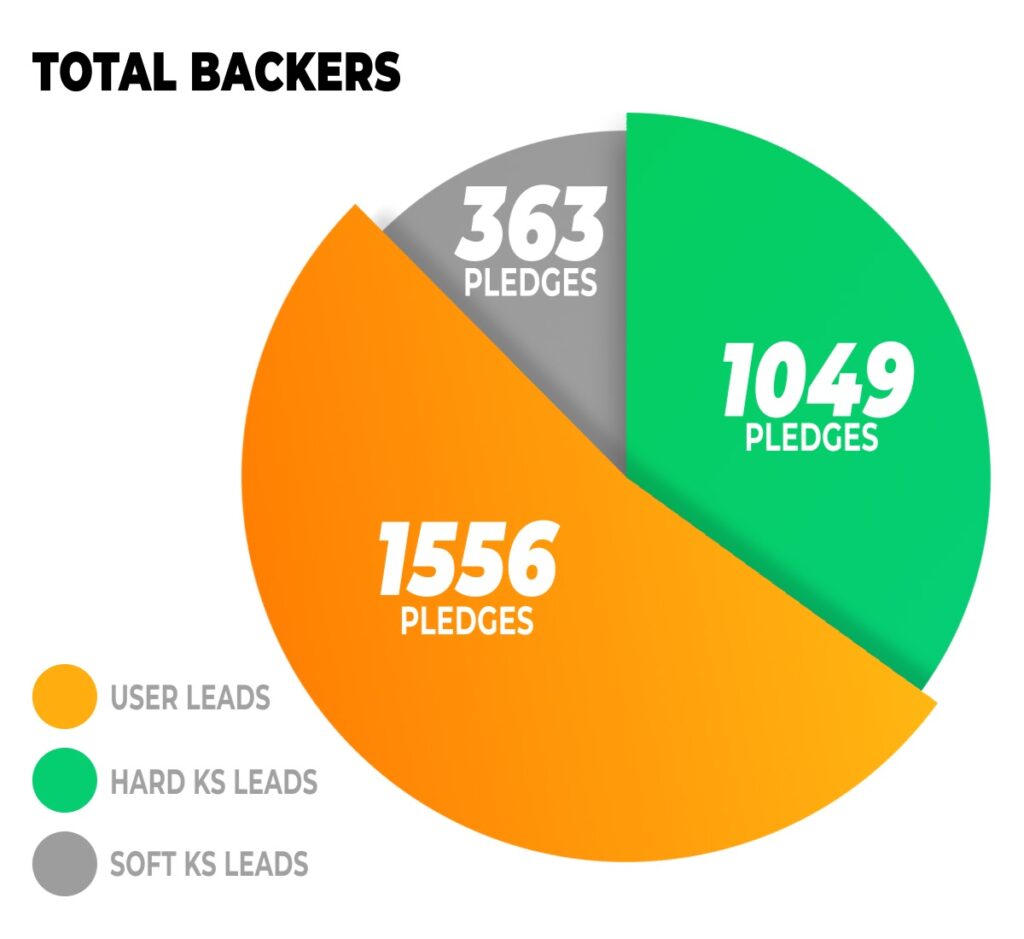
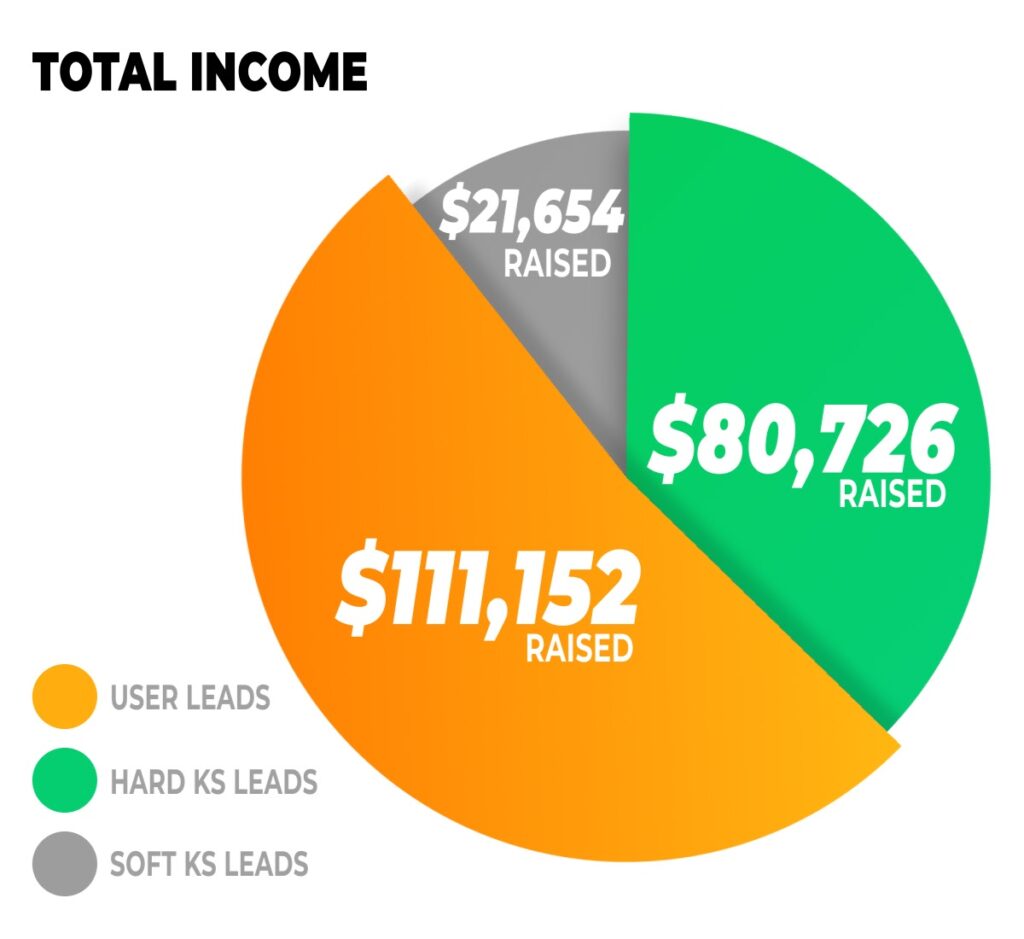
User Leads represents the majority of backers and the amount raised.
With soft-leads viewed as a handshake between you and Kickstarter, we decided to split pledges and backers from Soft Kickstarter Leads 50/50 between Hard Kickstarter Leads and User Leads. The below diagrams chart the soft-leads integration into the other referrals as a total percentile:
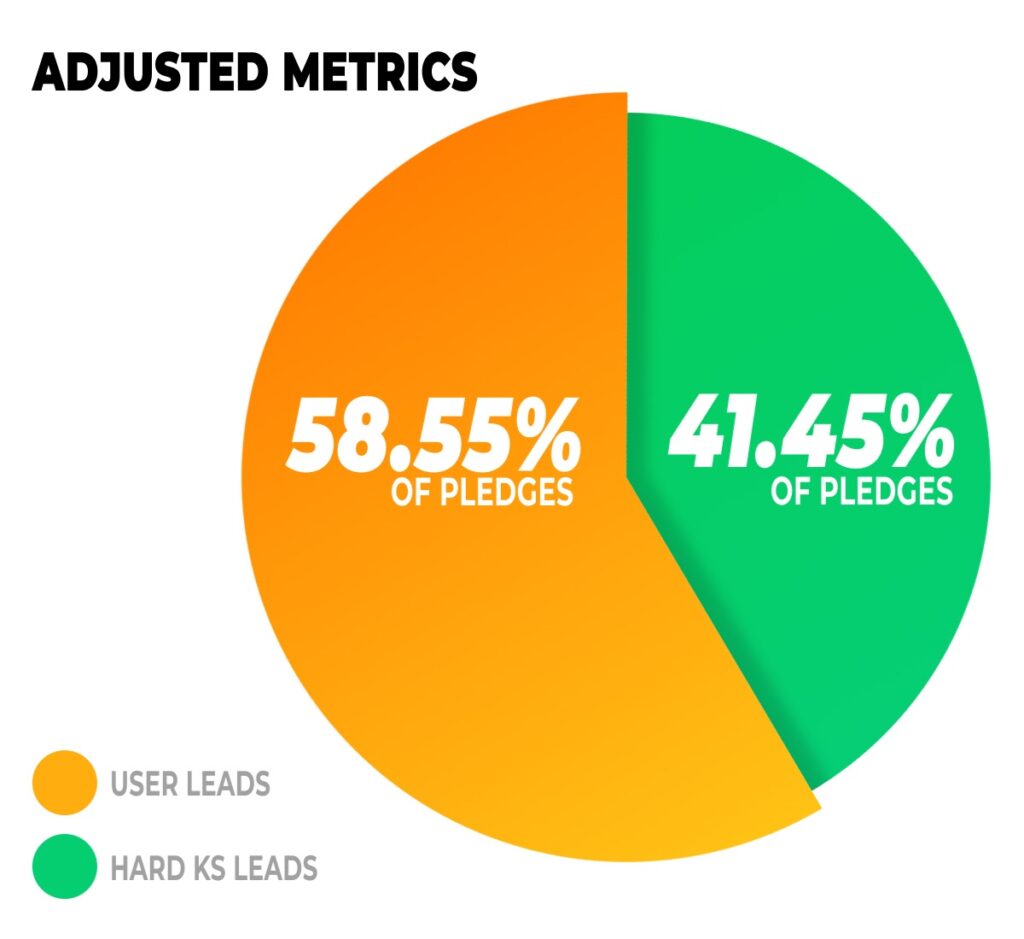
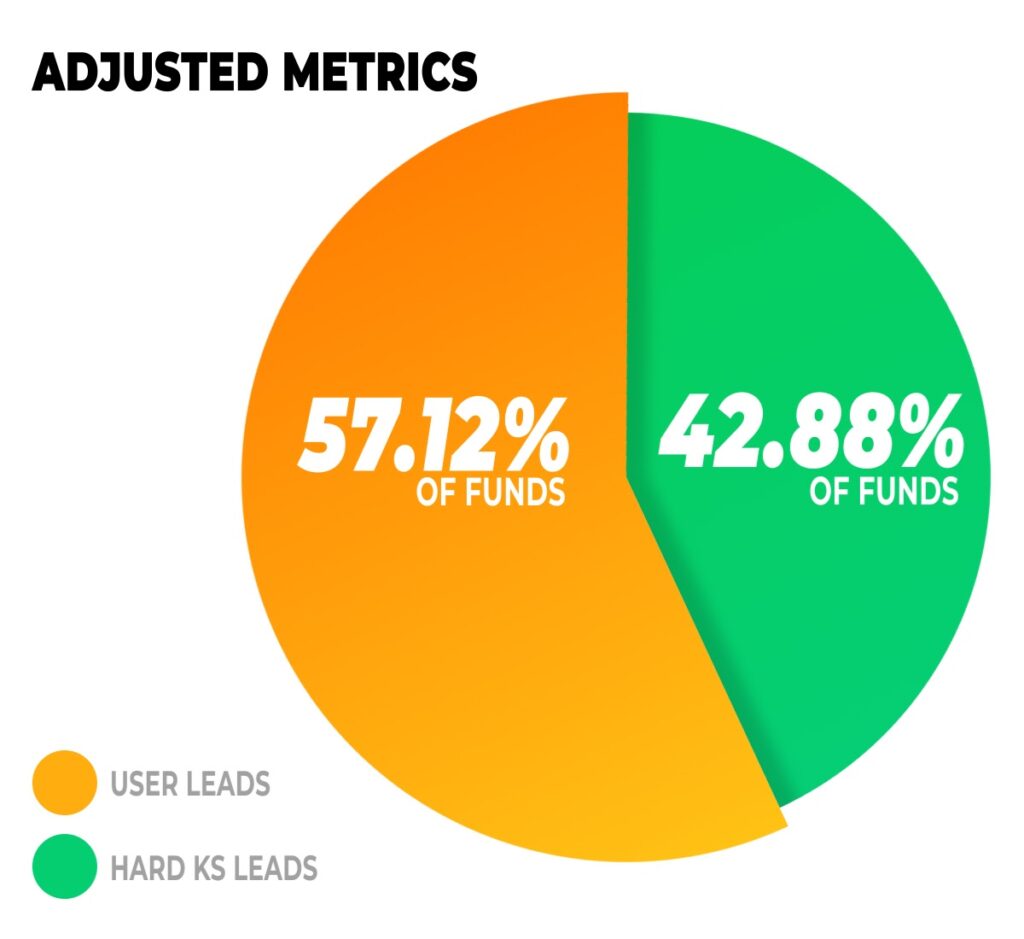
The conclusion in this case: 57.12% of all income generated is a result of the users hard work, while 42.88% was a result of Kickstarter’s algorithm pushing a game to new prospects. This is a very different view from the original pie chart Kickstarter provides in the user dashboard, which attributes 69% of referrals to Kickstarter:
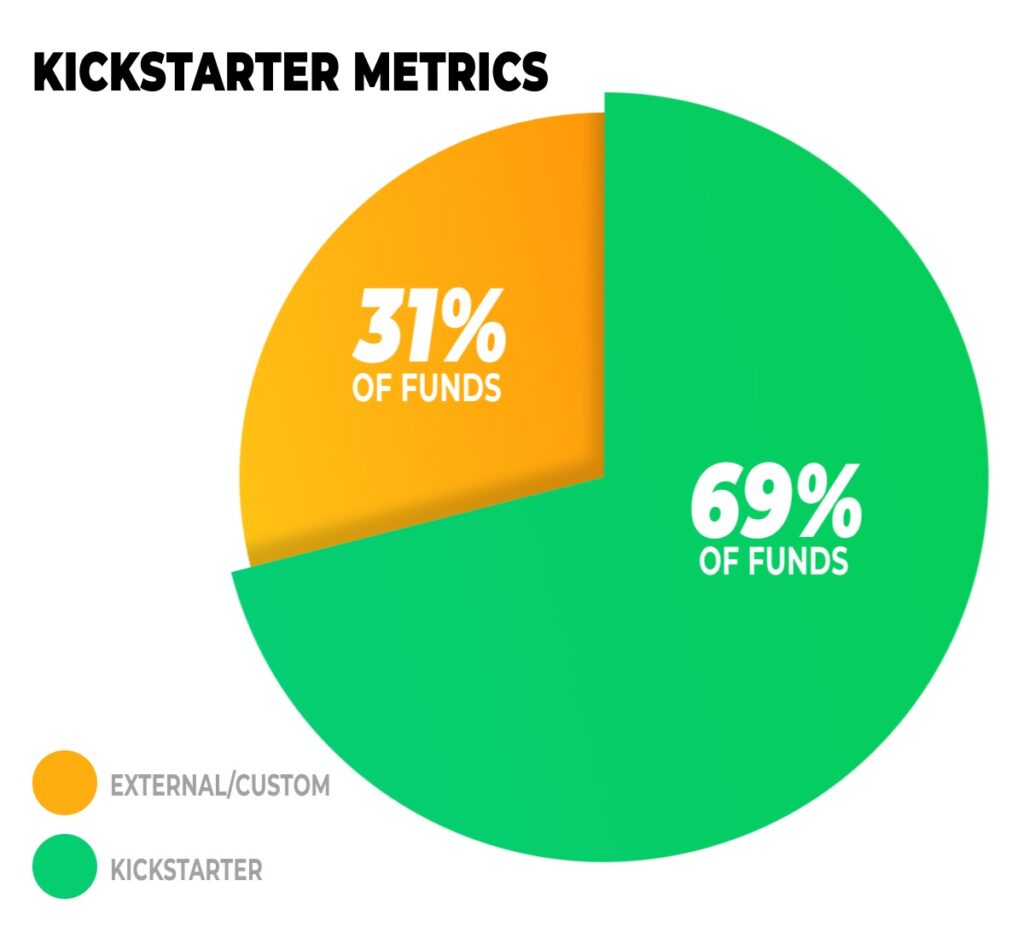
Averaging All Our Examples Together
A similar ~60/40 pledge split was consistently seen in the other campaigns we examined when following the same procedure. Compare the following average pledge from our examples and Kickstarter’s original metrics:


Between all the campaigns, on average there is a 21.64% discrepancy between Kickstarter’s referrals and what is most likely happening. Use this as a rough percentile when interpreting your data after your Kickstarter campaign. Subtract 20% from Kickstarter referrals in your dashboard after a campaign to have a better idea of how your investments paid off.
We also noticed that this 60/40 split was demonstrated in the total backers that were acquired through all the projects (in addition to funding).
The Most Funded Publishing Projects Of All Time On Kickstarter
The importance of building and mobilising your audience before launching your campaign is something even Kickstarter acknowledges in their case study of Brandon Sanderson’s The Way of Kings leather-bound book editions, which is the most funded publishing project of all time. The success of this campaign was primarily due to Brandon Sanderson’s vast and loyal fan-base that he had cultivated over the decades. Mr Sanderson boasts a mailing list of over 100,000 people!
With this in mind, alongside the insiders look of the data we’ve shown in our campaign examples, I hope you will be able to quantify the amount of work and effort that must be invested in your Kickstarter projects before you go live.
This is why we suggest a 3-month pre-marketing campaign before your Kickstarter launches, with a heavy emphasis on email marketing. Our measurement of success is in fully funding board games on launch day. You will only achieve the same results with quality pre-marketing. This sentiment was also communicated on Reddit by a former Kickstarter employee called ElectricSphynx that did an Ask Me Anything (AMA) segment:
“Getting fully funded in the first 24 hours is really important, so consider how many leads you need to reach it. You can also consider setting your funding goal at its absolute lowest you need to make the project happen, rather than at an aspirational level. To know how many leads you need to collect, consider that about 2% of leads typically convert, so if your funding goal is $10,000 and the price of a reward is $50 you need 200 backers. Because these 200 backers represent 2% of your leads collected, you need to collect 10,000 leads.”
ElectricSphynx reiterates the importance of pre-marketing when explaining common Kickstarter mistakes:
“A very common mistake is thinking that Kickstarter will somehow help you get traffic or traction, but that is absolutely not the case. You need to bring all the traffic and traction yourself, and they might boost it, but it won’t get you far without your own momentum.”
Conclusion: Ads Are Way More Effective Than They Get Credit For On Kickstarter
We concluded that about 60% of backers (or funds) of a Kickstarter campaign are generated by the creator’s efforts, and 40% of backers (or funds) are generated by Kickstarter.
That would mean, in simple math, that if you bring 6 backers, Kickstarter will bring 4 more. If you bring 6 pledges in through Facebook Ads, Kickstarter brings 4. If you bring in 100 backers from your pre-marketing e-mail list, Kickstarter brings in 67 more — Using my nerdy logic skills, that means that Facebook ads (or whatever ads you’re running) or your entire pre-marketing e-mail collection effort would be 67% more effective than you might have guessed at first.
If you’re thinking that Facebook ads or building an e-mail list is barely a worthwhile effort, now is when you should reconsider. You’re probably also one of those developer types that thinks it’s time to start marketing after a project is ready… and in that case, you desperately need our help now.
Another Conclusion: Kickstarter Is Great!
The Kickstarter push notifications that send emails to everyone you bring to your landing page helps create buzz around your launch. These push notifications also unite and mobilize your audience to share your products, making it a vital tool and service.
Kickstarter has worked hard to nurture a thriving board game community that are very familiar with the platform. On Kickstarter, your customers are also looking for things to buy, which makes conversions easier.
With our concluded 60/40 split in mind, the 5% Kickstarter fee is still an exceptional value seeing that about 40% of your overall funds raised can be attributed to Kickstarter alone.
The all-or-nothing fund model also means that Kickstarter has every financial incentive to see your projects succeed, compared to other crowdfunding platforms that take a cut if you fund or not.
Open Mic
In the comments below, share any questions you have that you felt were not answered and we will get back to you. Maybe we’ll even devote a future podcast or article to answering your question!
For more about Kickstarter marketing, including interviews, tips and strategies, forecasting, and nerding out about nerdy marketing stuff by nerds that love crowdfunding, check out our Crowdfunding Nerds podcast!
For more awesome articles about marketing for crowdfunding, join our e-mail list!
Crowdfunding Nerds Articles


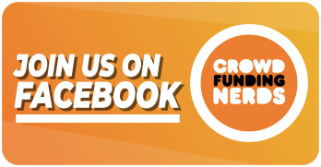






4 Replies to “Kickstarter Referrals Explained: Metrics Of 4 Funded Tabletop Campaigns”